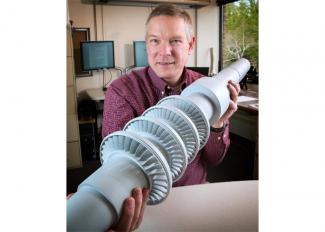Photo Caption: Image courtesy of Gas Technology Institute. The new STEP facility, supported by NETL, will house a desk-sized sCO2 turbine that could power 10,000 homes.
 Key recommendations to guide the operation of a first-of-its-kind testing facility to develop next-generation power plants have been issued by NETL researchers. If successful, testing at this facility will provide a pathway to lower the cost of electricity, shrink the environmental and physical footprint of power generation systems and conserve water.
Key recommendations to guide the operation of a first-of-its-kind testing facility to develop next-generation power plants have been issued by NETL researchers. If successful, testing at this facility will provide a pathway to lower the cost of electricity, shrink the environmental and physical footprint of power generation systems and conserve water.
In a paper published in the journal Applied Energy, NETL’s Eric Liese, Jacob Albright and Stephen E. Zitney outlined process control models and operating strategies for the new Supercritical Transformational Electric Power (STEP) pilot plant, which is scheduled to open in 2021 on the Southwest Research Institute campus in San Antonio, Texas.
Supported with funding by the U.S. Department of Energy (DOE) and industry partners, the STEP plant, a 10-megawatt pilot scale facility, is designed to test the use of supercritical carbon dioxide (sCO2) as the working fluid for advanced power generation stations.
Current power plants use water as the working fluid to produce high-pressure steam that drives turbines. The use of sCO2 offers a higher-efficiency alternative and multiple benefits, including a reduction in water consumption, to produce electricity.
The ability of sCO2 to serve as superior working fluid is found in the fact that when it’s held above a critical temperature and pressure (88 degrees Fahrenheit and 1070 psi), sCO2 acts like a gas while having the density of a liquid. Such enhancements mean sCO2 turbomachinery can be one-tenth the size of conventional power plant components. Also, a single desk-sized sCO2 turbine could potentially power 10,000 homes, creating a new generation of power plants that will use less fuel, produce fewer greenhouse gas emissions and require less space.
In their study, “Startup, shutdown and load-following simulations of a 10 MWe supercritical CO2 recompression closed Brayton cycle,” the NETL researchers used dynamic modeling software to analyze a broad spectrum of potential control strategies and operational scenarios of the STEP pilot plant. The work generated improved operating procedures and control strategies to meet flexible power generation demands and minimize the negative impacts on cycle efficiency and equipment wear and tear.
The study demonstrated effective simulations for ramping up and ramping down in response to changes in electricity demand, operational methods to prevent damage to compressors, heat exchangers and other equipment, and strategies to initiate shutdowns and restarts within expected process constraints and while reducing risk to plant operations.
The dynamic process modeling work is an important contributor to risk reduction during commissioning and startup operations of the STEP facility, with the research findings directly transferable to large-scale systems and associated analyses. It is also more broadly applicable to controls and operations for sCO2 cycle applications using concentrated solar and nuclear energy sources.
In general, studies have shown the use of sCO2 as the working fluid increases energy output regardless of the thermal fuel source. Where fuel costs are a significant portion of overall costs of power generation (for example, coal- and natural gas-fired plants), the benefit is reduced fuel use and the associated costs. Where capital investments are high (for instance, nuclear and concentrating solar power), the benefit is increased power output for the initial investment, thereby reducing the cost of electricity.
NETL’s recent findings will be presented to STEP project partners to help prepare for plant commissioning next summer. The Gas Technology Institute is the prime recipient of the cooperative agreement to build the plant while the Southwest Research Institute and General Electric Global Research are sub-recipients.
The STEP plant will be capable of being reconfigured to accommodate potential future testing of system/cycle upgrades, new cycle configurations, and new or upgraded components in addition to next-generation turbomachinery and heat exchanger technology. Other STEP objectives include refining the sCO2 power cycle, demonstrating component performance and scalability, designing the facility to accommodate multiple new supporting technologies and reducing barriers to technology commercialization.
The U.S. Department of Energy’s National Energy Technology Laboratory develops and commercializes advanced technologies that provide reliable and affordable solutions to America’s energy challenges. NETL’s work supports DOE’s mission to advance the national, economic and energy security of the United States.





 Key recommendations to guide the operation of a first-of-its-kind testing facility to develop next-generation power plants have been issued by NETL researchers. If successful, testing at this facility will provide a pathway to lower the cost of electricity, shrink the environmental and physical footprint of power generation systems and conserve water.
Key recommendations to guide the operation of a first-of-its-kind testing facility to develop next-generation power plants have been issued by NETL researchers. If successful, testing at this facility will provide a pathway to lower the cost of electricity, shrink the environmental and physical footprint of power generation systems and conserve water.